In this comprehensive guide, I provide you the most effective and practical methods to unclog your bathtub drain.
Dealing with a clogged bathtub drain with standing water can be frustrating.
However, there is good news. There are many DIY solutions to remedy this common problem.
So, let’s get started with a list of common items used to unclog drains.
Unclog Bathtub Drain with Standing Water – Common Tools and Materials
Drain PlungerRubber Gloves
Collapsible Bucket
Handheld Drain Claw
Baking Soda
Vinegar
Measuring Cup
Plumber’s Snake
Salt
Wire Coat Hanger
Dish Soap
Wet-Dry Vac
Hydrogen Peroxide
Coca-Cola
Pressure Washer Drain Jet
Enzyme Based Drain Cleaner
Chemical Drain Cleaner
1 – Boiling Water
In most cases, boiling water is the best solution to unclog drains.
Boiling water is a natural and chemical-free method to resolve bathtub clogs.
The high temperature of the water helps to dissolve and loosen the buildup of hair, soap scum, and other debris that may be causing the clog.
In addition, boiling water unclogs a kitchen sink drain, toilet drains, bathroom sinks, a garbage disposal, and even a clogged shower drain.
Safety Precautions
Using boiling water to unclog a bathtub drain can be effective for some types of clogs, but there are also potential risks and considerations to keep in mind.
PVC Pipe Damage: If your plumbing system includes PVC pipes, extremely hot water can soften or damage them. Only use boiling water with metal pipes.
Splash and Burns: Boiling water can cause splashing when poured down the drain, posing a risk of burns to your skin. Be cautious and wear protective gloves and eyewear if necessary.
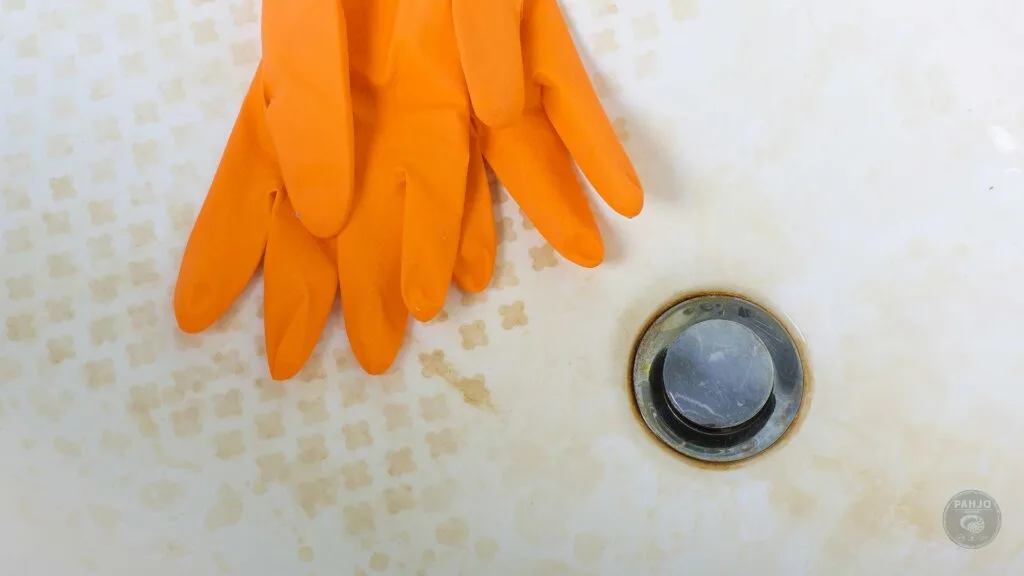
Ineffectiveness: Boiling water might not be effective for certain types of clogs, especially those caused by solidified grease or hard materials. In such cases, the boiling water might not break down the clog enough to clear the drain.
Noisy Pipes: Rapid temperature changes caused by pouring boiling water down a drain with cold water can potentially cause pipes to expand or contract. As a result, this leads to knocking or creaking sounds within pipes.
Limited Use: Boiling water is most effective for relatively minor clogs caused by soap scum and debris. It might not be sufficient for more stubborn or complex clogs.
To minimize risks and improve the effectiveness of using boiling water to unclog a bathtub drain:
- Use caution when handling boiling water to prevent burns.
- If you’re unsure about the type of pipes in your plumbing system, consider using warm or hot water rather than boiling water.
- Pour the water slowly to minimize splashing.
- If using boiling water alone doesn’t clear the clog, try combining it with other methods like plunging, using a drain snake, or using natural cleaning agents like baking soda and vinegar.
- The following steps will help you unclog your bathtub drain using boiling water:
How to Unclog Bathtub Drain with Boiling Water
First, I listed the items needed below:
Drain PlungerRubber Gloves
Collapsible Bucket

The following steps will help you unclog bathtub drain using boiling water.
- Boil water – Fill a large pot or kettle with water and bring it to a rolling boil. Use enough water to completely cover the drain opening.
- Remove standing water – If there is standing water in the bathtub, remove as much as possible using a bucket or container.
- Pour the boiling water – Carefully pour the boiling water directly into the drain in a slow and controlled manner. Start by pouring a small amount and gradually increase the flow if necessary.
- Repeat if needed – If the clog does not clear immediately, allow the water to work its way through the drain for a few minutes. Repeat the process if required.
- Lastly, run hot water from the faucet to check if the clog has cleared. If the water flows freely, congratulations! Your bathtub drain is now unclogged.
Preventive Measures
To avoid future clogs in your bathtub drain, consider taking these preventive measures:
- Use a drain stopper or pop-up stopper: These simple devices can catch hair and debris, preventing them from going down the drain.
- Regular cleaning: Periodically clean your drain by pouring boiling water down it to remove any buildup before it becomes a problem.
- Hair traps: Invest in a hair trap or drain cover to catch hair before it enters the drain, reducing the likelihood of clogs.
2 – Plunger
First, the recommended tools are below:
Drain PlungerRubber Gloves
Collapsible Bucket
The easiest way to fix a stubborn clog is with a plunger.

As a quick tip, use a plunger specifically designed for drains and shower clogs.
Obviously, a toilet plunger will not work well to unclog drains.
How to Use a Plunger to Unclog Bathtub Drain with Standing Water
First, remove any visible debris or hair from the drain.
This helps prevent further blockages during the process.
Also, rubber gloves protects your hands from stagnant water.
As a next step, fill the tub with enough water to cover the bottom of the plunger.
This water will create the necessary seal and pressure to dislodge the clog.
In addition, the water level should be sufficient to cover the bottom of the plunger’s rubber cup.
Position the plunger over the drain, ensuring that the rubber cup fully covers the drain opening.
Make sure there is no air escaping around the edges of the plunger.
A tight seal is crucial for optimal suction and pressure.
With both hands, hold the plunger’s handle and begin plunging up and down vigorously.
Apply firm pressure without lifting the plunger off the drain surface.
The suction created by the plunging motion will dislodge the clog.
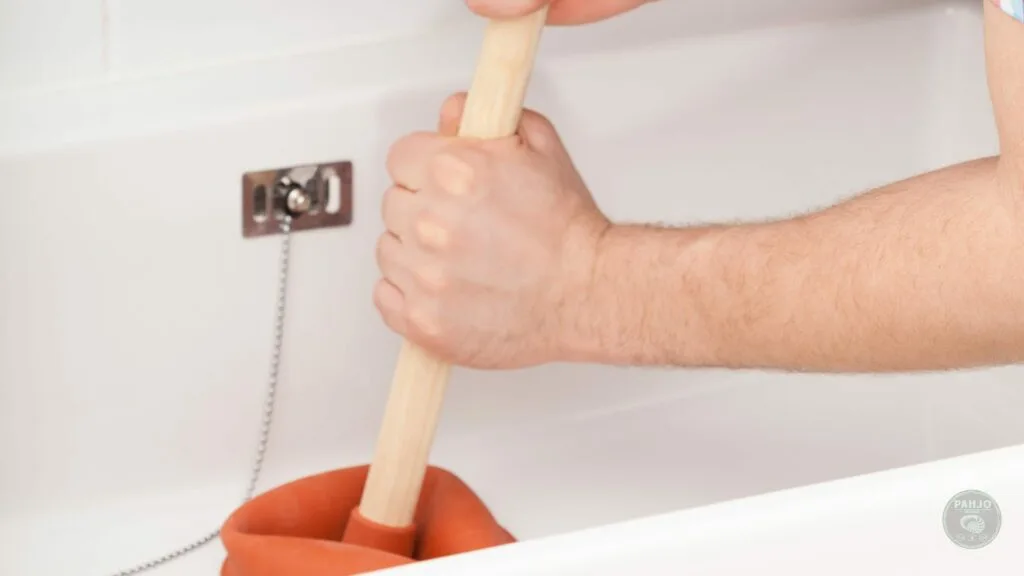
Continue plunging for several minutes, maintaining a consistent and forceful motion.
If the clog is stubborn, try various angles and directions to break it up.
Be patient and persistent, as it may take several attempts to clear the drain completely.
After plunging, remove the plunger and carefully test the drain by running water.
If the water flows smoothly, the clog has likely been cleared.
Repeat the plunging process or consider trying another method if this doesn’t work.
Once the drain is clear, clean up any excess water and debris that may have accumulated.
Dispose of the debris properly to prevent any further clogging.
Additionally, consider implementing preventive measures such as using drain covers to catch hair and regularly pouring hot water down the drain to flush out any potential build-up.
Unclogging a bathtub drain with a plunger is an effective and straightforward method that can save you time and money.
3 – Handheld Drain Claw
Unclogging a bathtub drain with a handheld drain claw is a simple and effective method.
In addition, this works best for visible blockages.
How To Use a Handheld Drain Claw to Unclog Drain
The first thing to do is remove the drain cover.
Most drain covers easily lift or unscrew.
Next, insert the drain claw into the drain.
Push it as far as you can until you feel some resistance.
Rotate the drain claw.
This will help grab any hair, debris, or other clogs that may be causing the blockage.
Slowly pull out the drain claw.
Be patient and avoid rushing this step to ensure that you remove any clogs.
Discard any debris or clogs that you pull out of the drain.
Run hot water down the drain to flush out any remaining debris.
Obviously, this will help confirm if the clog has been completely removed.
Then, replace the drain cover and test the drain by running water to ensure it is now unclogged.
Remember, if the clog persists or if you encounter any difficulties during the process, it’s advisable to seek professional help from a plumber.
4 – Baking Soda and Vinegar
Unclogging a bathtub drain with baking soda and vinegar is an effective and natural method that can help clear minor clogs.
How to Unclog Bathtub Drain using Baking Soda and Vinegar
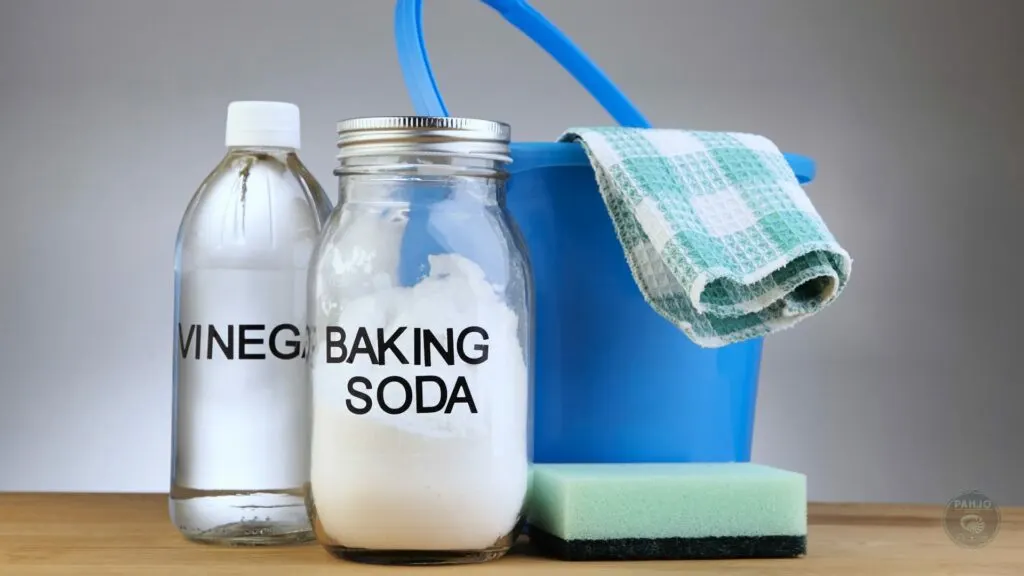
Start by boiling a kettle or pot of water. You’ll need this later in the process.
If there is standing water in the bathtub, remove as much as possible using a cup or bucket. It’s important to have a clear drain before proceeding.
Pour about 1/2 cup of baking soda down the drain. Make sure to distribute it evenly across the drain opening.
Pour about 1 cup of white vinegar down the drain. It will react with the baking soda, causing a fizzing and bubbling reaction. This reaction helps to break down the clog.
Immediately after pouring the vinegar, plug the drain with a drain stopper or a cloth. This will prevent the fizzing action from escaping and allow it to work directly on the clog.
Let the baking soda and vinegar mixture sit in the drain for about 30 minutes. This will give it time to work on breaking down the clog.
After 30 minutes, carefully remove the drain stopper or cloth and slowly pour the boiling water down the drain. Start with a small amount and gradually increase the flow. The hot water will help flush away any remaining debris and clear the clog.
Run water in the bathtub to check if the clog is cleared. If the water drains smoothly, you have successfully unclogged the drain using baking soda and vinegar.
Remember, this method is most effective for minor clogs.
5 – Plumber’s Snake
Unclogging a bathtub drain with a plumbing snake is a straightforward process.
How to Use a Plumber’s Auger to Unclog Bathtub Drain
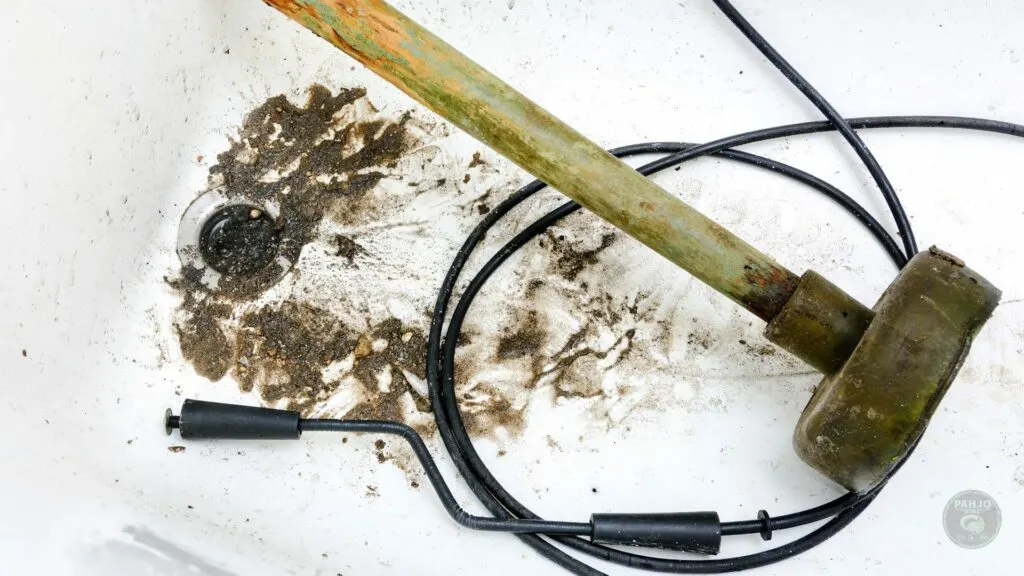
First, you’ll need a plumbing snake, sometimes called a drain auger, which is a long, flexible metal tool with a coiled wire at the end.
Next, unscrew or lift the drain stopper to expose the drain opening.
Some stoppers can be easily removed by hand, while others may require a screwdriver.
Insert the coiled end of the snake into the drain opening.
Gently push it in until you feel resistance, which indicates that you have reached the clog.
With the snake inserted, rotate the handle clockwise while pushing it further into the drain.
The snake’s wire will help break up the clog and grab onto debris.
Slowly pull the snake back out of the drain, bringing the clog with it.
Be cautious not to force the snake or pull too abruptly, as this could cause damage to the plumbing.
Once you’ve removed the clog, run water down the drain to ensure it is flowing freely.
If the water drains smoothly, you’ve successfully unclogged the bathtub drain.
Clean the plumbing snake: After use, clean the plumbing snake thoroughly to remove any debris or residue.
This will help maintain its effectiveness for future use.
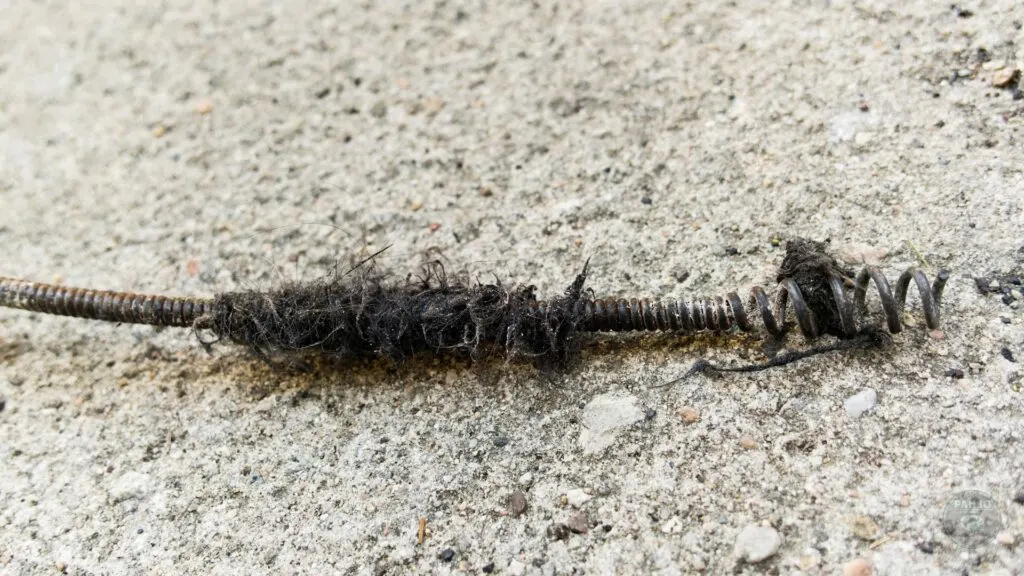
Remember, using a plumbing snake requires some caution and skill.
Severe or persistent clogs may require the expertise of a plumber to avoid causing further damage to the plumbing system.
6 – Salt and Baking Soda
Combining salt and baking soda is a natural and environmentally friendly method to help unclog a drain. This mixture can be effective for breaking down grease, grime, and mild clogs.
How to Use Salt and Baking Soda to Unclog Bathtub Drain
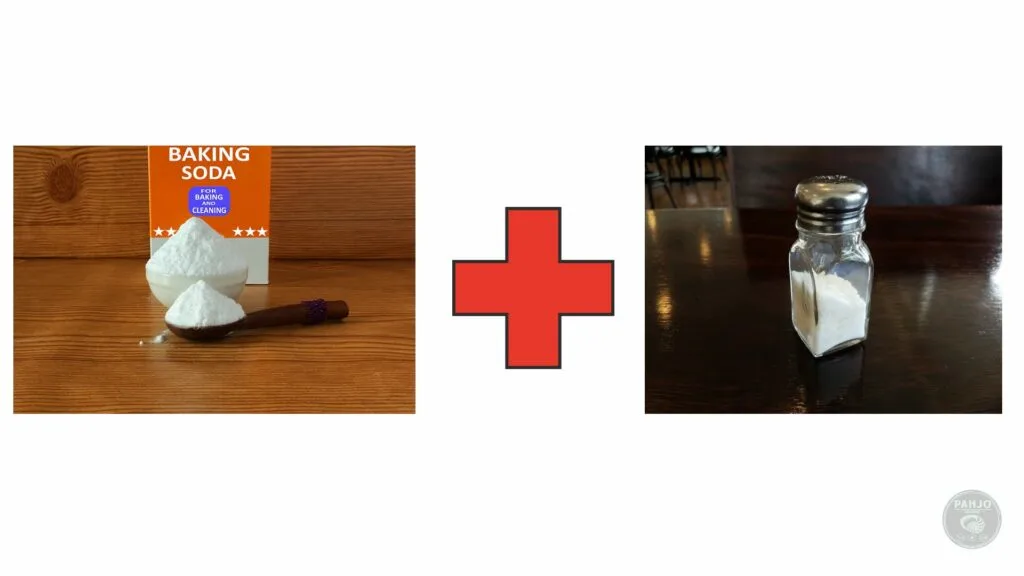
- Remove any standing water from the bathtub using a bucket or cup.
- In a measuring cup, mix equal parts of salt and baking soda in a bowl. For a standard-sized bathtub, you will need about 1/2 cup of each.
- Carefully pour the mixture down the drain. Make sure to pour it slowly to avoid any spillage.
- Let the mixture sit in the drain for about 10-20 minutes. This will allow the salt and baking soda to work on breaking down the clog.
- Boil a pot of water while waiting for the mixture to take effect. Once the time is up, carefully pour the hot water down the drain.
- Use a plunger to further dislodge the clog. Place the plunger over the drain and create a tight seal. Push and pull the plunger vigorously for about 30 seconds to a minute.
- If the clog still persists, repeat the process or try using a plumbing snake to break up the debris.
Remember, when using this method, be cautious and take safety precautions.
Avoid using this method if you have PVC or plastic pipes, as the mixture can damage them.
If the clog remains stubborn or if you have any concerns, it’s best to seek professional help.
7 – Wire Coat Hanger
Unclogging a bathtub drain with a wire hanger is a simple and effective method.
How To Use a Coat Hanger to Unclog a Drain
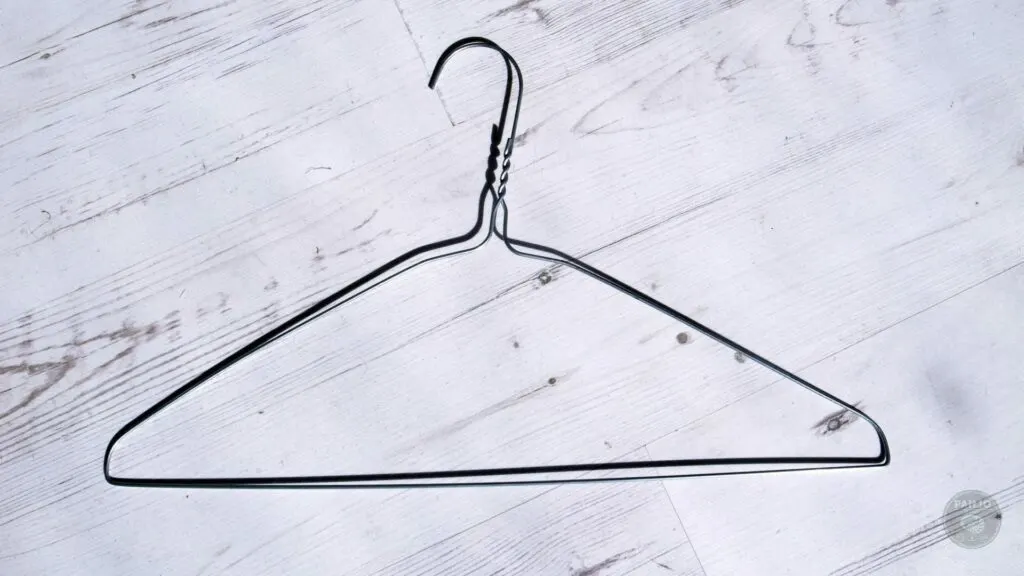
- Straighten the hanger: Take a wire hanger and straighten it as much as possible. Leave the hook part intact.
- Create a hook: Bend one end of the hanger to create a small hook. This will help you grab and pull out any clogs or debris from the drain.
- Remove the drain cover: If your bathtub has a removable drain cover, unscrew or pry it off using a screwdriver or pliers. Skip this step if your drain doesn’t have a cover.
- Insert the hanger: Insert the hooked end of the hanger into the drain. Gently push it in until you feel resistance.
- Fish out the clog: Move the hanger around in a circular motion or side to side to catch the clog or debris. Be careful not to push the clog further down the drain.
- Pull out the clog: Once you’ve caught the clog, slowly pull it out. If it’s a large clog, you may need to twist the hanger to dislodge it.
- Repeat if necessary: If the drain is still not fully clear, repeat the process until you remove all the clogs or debris.
- Flush the drain: After removing the clog, turn on the hot water and flush the drain for a few minutes to ensure it’s completely clear.
Remember to exercise caution while using the wire hanger to avoid scratching or damaging the drain pipe.
8 – Dish Soap and Boiling Water
Using dish soap and boiling water to unclog a drain is a simple and relatively gentle method.
In addition, this works best for minor clogs caused by grease, oils, and soap scum.
How To Use Dish Soap and Boiling Water to Unclog Bathtub Drain
- Boil a pot of water: Fill a pot with water and bring it to a rolling boil on your stovetop. The hot water will help break down the clog.
- Pour dish soap into the drain: Squirt a generous amount of dish soap directly into the clogged drain. Dish soap has surfactants that can help dissolve grease and other substances causing the clog.
- Pour the boiling water down the drain: Carefully pour the boiling water into the drain. Start with a small amount to avoid any potential splashing. The hot water will help break down the clog and flush it away.
- Repeat if necessary: If the clog doesn’t clear after the first attempt, repeat the process. Sometimes stubborn clogs require multiple tries to fully dissolve and clear.
- Test the drain: After pouring the boiling water, wait for a few minutes and then test the drain by running water. If the water flows smoothly, the clog is likely cleared. If not, you may need to try other methods or seek professional help.
Note: This method works best for minor clogs caused by soap scum, grease, or hair.
9 – Wet-Dry Vacuum
Unclogging a bathtub drain using a wet-dry vacuum is a simple and effective method.
How To Unclog Drain with Wet-Dry Vacuum
- Start by removing any standing water from the bathtub using a bucket or cup.
- Attach the wet-dry vacuum hose to the appropriate intake port.
- Ensure the vacuum is set to the “wet” setting to handle water.
- Place the vacuum hose directly over the drain, creating a tight seal.
- Turn on the vacuum and let it run for a few minutes, allowing it to suck out the clog.
- If the clog is stubborn, you can try to create a tighter seal by covering the overflow drain with a cloth or towel.
- Once you feel the clog has been cleared, turn off the vacuum and remove the hose.
- Run hot water down the drain to check if it is flowing freely.
- If the water is draining properly, your bathtub drain is now unclogged.
Remember, this method works best for small to moderate clogs.
10 – Hydrogen Peroxide and Baking Soda
Combining hydrogen peroxide and baking soda can create a foaming reaction that helps to break down clogs and clear drains.
How to Unclog Bathtub Drain with Hydrogen Peroxide and Baking Soda
To unclog a bathtub drain using hydrogen peroxide and baking soda, follow these steps:
- Remove any standing water from the bathtub using a cup or bucket.
- Pour half a cup of baking soda into the drain. Make sure to distribute it evenly.
- Slowly pour half a cup of hydrogen peroxide into the drain. It will react with the baking soda, creating a foaming action.
- Let the mixture sit in the drain for about 30 minutes. This will allow the baking soda and hydrogen peroxide to break down the clog.
- Boil a pot of water while waiting for the mixture to work. Once the 30 minutes are up, carefully pour the boiling water down the drain. The hot water will help flush away any remaining residue and unclog the drain.
- Test the drain by running water to see if it’s flowing freely. If the clog persists, you may need to repeat the process or consider using a different method.
Remember to exercise caution when handling chemicals.
11 – Coca-Cola
Unclogging a bathtub drain with Coca-Cola is a common DIY method that can be effective in certain situations.
How To Use Coca-Cola to Unclog a Drain
- Start by removing any standing water from the bathtub. You can use a cup or a bucket to scoop it out.
- Pour a large pot of boiling water down the drain. This will help loosen any gunk or debris lodged in the pipe.
- Open a can or bottle of Coca-Cola. Make sure it is at room temperature and not carbonated, as the carbonation might cause splashing.
- Slowly pour the entire can or bottle of Coca-Cola down the drain. The phosphoric acid in Coca-Cola can help break down organic matter and loosen clogs.
- Let the Coca-Cola sit in the drain for at least one hour. This will give it time to work its magic and dissolve any buildup.
- After an hour, flush the drain with hot water. You can use boiling water again to ensure any remaining debris is flushed away.
- If the drain is still clogged, you may need to repeat the process or consider using a different method.
It’s important to note that while Coca-Cola can be effective for minor clogs, it may not work for more severe or stubborn blockages.
12 – Pressure Washer Drain Jet
Unclogging a bathtub drain using a pressure washer drain jet can be an effective method.
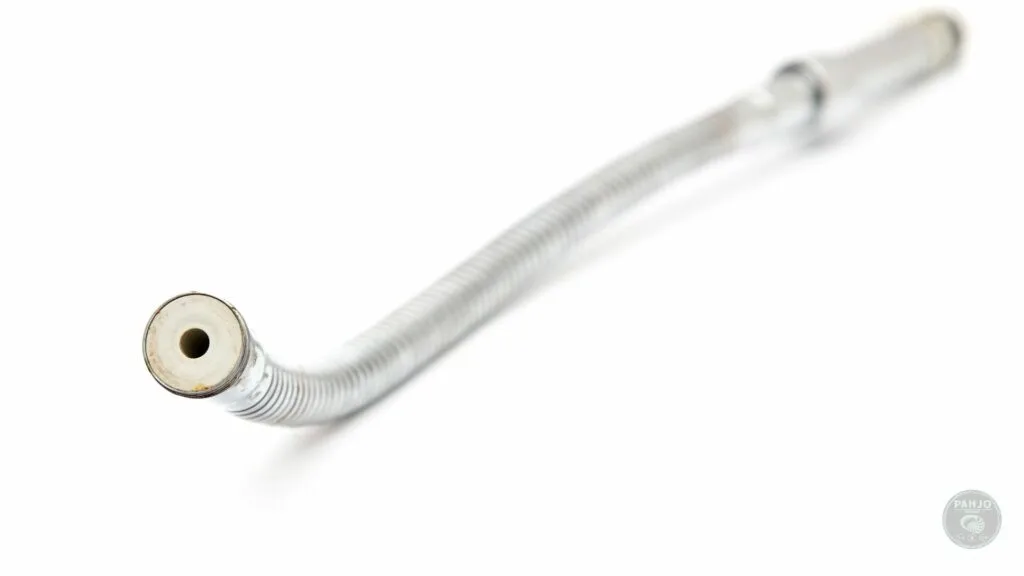
How To Unclog Bathtub Drain with a Drain Jet
- Safety first: Put on protective gear such as gloves and safety glasses to protect yourself from any potential splashes or debris.
- Remove the drain cover: Unscrew or lift the drain cover to expose the drain opening. If the drain cover is fixed, use a screwdriver or pliers to remove it.
- Attach the pressure washer drain jet: Take your pressure washer drain jet attachment and secure it to the end of your pressure washer hose according to the manufacturer’s instructions.
- Insert the drain jet into the drain: Carefully insert the drain jet into the drain opening. Make sure it fits securely to avoid any leaks.
- Turn on the pressure washer: Start the pressure washer and gradually increase the water pressure. Be cautious not to use excessive pressure, as it may damage the pipes or fixtures.
- Direct the jet into the clog: Position the drain jet to aim directly at the clog. Move it back and forth to dislodge and break up the blockage. Continue this process until the water flows freely down the drain.
- Flush the drain: Once the clog is cleared, flush the drain with hot water for a few minutes to ensure any remaining debris is completely removed.
- Clean up: Disconnect the pressure washer drain jet attachment and clean it thoroughly. Replace the drain cover and clean up any excess water or debris around the tub.
Note: Using a pressure washer drain jet can be an effective method for stubborn clogs, but exercise caution to avoid damage to the pipes or fixtures.
13 – Enzyme Based Cleaners
Unclogging a bathtub drain with enzyme-based cleaners is a straightforward process.
These cleaners contain natural enzymes that break down organic substances, such as hair and soap scum, which are common causes of bathtub drain clogs.
How To Use Enzyme Based Cleaner to Unclog Bathtub Drain
- Purchase an enzyme-based drain cleaner: Visit your local hardware store or home improvement center and look for a drain cleaner specifically labeled as enzyme-based.
- Read the instructions: Before starting, carefully read and follow the instructions provided by the manufacturer. Different enzyme-based cleaners may have slightly different application methods, so it’s essential to understand the specific guidelines for the product you’ve purchased.
- Protect yourself: Put on a pair of rubber gloves to protect your hands from the chemicals in the cleaner.
- Remove any visible debris: Use a pair of needle-nose pliers or tweezers to remove any visible debris, such as hair, from the drain opening. This will help improve the effectiveness of the enzyme-based cleaner.
- Pour the cleaner down the drain: Slowly pour the recommended amount of enzyme-based cleaner down the bathtub drain. Follow the instructions on the product for the proper dosage.
- Let it sit: Allow the enzyme-based cleaner to sit in the drain for the specified amount of time recommended by the manufacturer. This can range from a few minutes to several hours, depending on the severity of the clog.
- Run hot water: After the designated waiting period, run hot water down the drain for a few minutes. The hot water will help flush out the loosened debris and clear the drain.
- Repeat if necessary: In some cases, a single treatment may not completely clear the clog. If the drain is still partially blocked, repeat the process by pouring another dose of the enzyme-based cleaner down the drain and letting it sit for the recommended time before rinsing with hot water again.
Remember, if the clog persists or if you’re unsure about using enzyme-based cleaners, it’s always wise to consult a professional plumber who can provide expert advice and assistance.
14 – Chemical Drain Cleaner
Chemical drain cleaners are designed to break down clogs and clear blockages in pipes using a chemical reaction.
Additionally, these cleaners typically contain powerful chemicals, such as sodium hydroxide (lye) or sulfuric acid, which work to dissolve organic matter, hair, soap scum, and other debris that can cause a clogged tub drain.
Ultimately, unclogging a bathtub drain with a chemical drain cleaner is a straightforward process.
How To Unclog Bathtub Drain Using a Drain Cleaner
- Purchase a suitable commercial drain cleaner from your local hardware or home improvement store. Make sure to choose a product that is specifically designed for clearing bathtub drains.
- Read and follow the instructions provided on the label of the drain cleaner carefully. Different products may have slightly different usage guidelines, so it’s important to follow them precisely.
- Put on protective gloves and safety goggles to protect your skin and eyes from any potential splashes or fumes.
- Remove any standing water from the bathtub using a bucket or a cup. It’s important to have a clear drain before applying chemical cleaners.
- Pour the recommended amount of the drain cleaner directly into the clogged drain. Typically, the instructions will specify the appropriate quantity based on the severity of the clog.
- Allow the drain cleaner to sit in the drain for the specified amount of time mentioned on the label. This waiting period allows the chemicals in the cleaner to break down the clog.
- After the designated time has passed, run hot water into the drain to flush out the clog and drain cleaner. Be cautious and avoid any contact with the drain cleaner as it may still be harmful.
- If the clog persists, repeat the process or try an alternative method.
Remember to always exercise caution and follow the safety instructions provided by the manufacturer when using commercial drain cleaners.
Additionally, caustic chemicals may be harmful to the environment.
So, use this type of solution to unclog bathtub drain with standing water as a last resort.
15 – Hire a Professional Plumber

If the clog is persistent or none of the DIY methods work, it’s wise to seek assistance from a professional plumber.
What Causes Bathtub Drains to Clog
Understanding the common cause of clogged tub drains help prevent a future plumbing issue.
Therefore, I listed the common culprits that lead to a bathtub drain clog.
Hair Accumulation
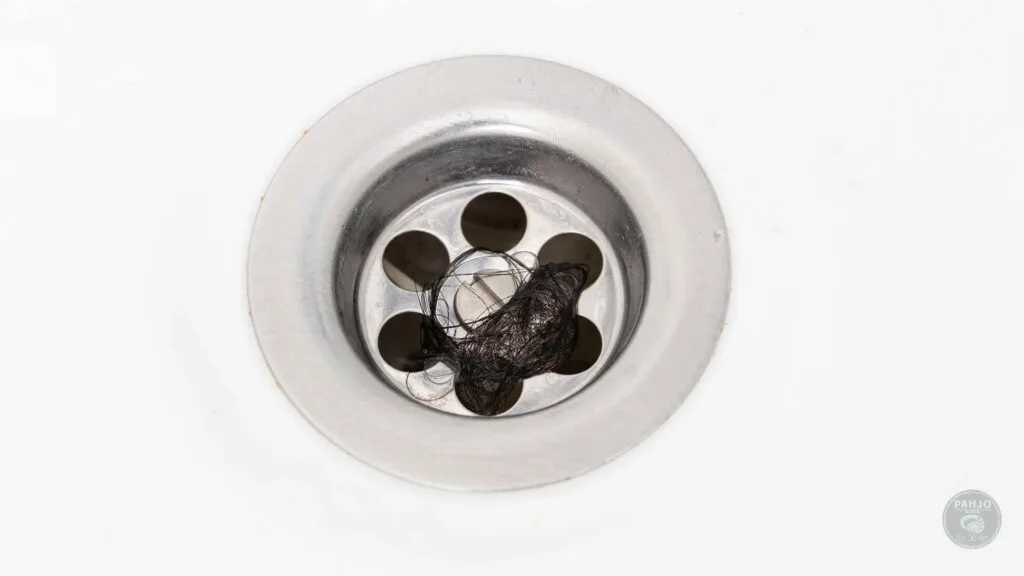
Hair clogs lead the list of things that cause a bathtub’s drain to clog.
As you shower, loose hair travels down the drain and combines with soap residue.
Over time, long hair creates a tangled mess that obstructs water flow.
Fortunately, there is an easy fix to prevent the build-up of hair.
The best way to prevent hair from entering the drain is to install a hair catcher or bathtub stopper.

Soap Scum
Soap and hair care products may seem harmless, but it accumulates within drain pipes.
As a result, it leads to a slow draining bathtub.
Basically, soap combines with minerals in the water and forms a sticky substance.
Next, this attracts other particles and forms clogs.
It is a good idea to clean your drain regularly and/or using less soap to solve this issue.
Mineral Buildup
Hard water can lead to mineral deposits building up inside your pipes.
This accumulation reduces the diameter of the pipes, making it easier for debris to get caught and causing slow drainage.
Using a water softener or periodically flushing your pipes with a cup of vinegar can help prevent mineral buildup.
Foreign Objects
Small items like jewelry, bottle caps, and even children’s toys get stuck near the top of the drain.
Ensuring that the drain is covered and being cautious with what goes down the drain can help prevent this issue.
Excessive Grease and Oil
While it might be tempting to wash off oily substances in the bathtub, it will eventually cause a drainage issue.
Also, grease and oil may solidify within the drain pipes and trap debris, which will lead to a blocked drain.
Furthermore, properly disposing of grease and using a mesh strainer can prevent this issue.
Inadequate Drain Slope
Sometimes, the design of the drain can contribute to clogs.
For example, water may not flow down the drain lines if the drainpipe isn’t sloped properly.
Due to the potential complexity of this issue, consult a professional plumber to fix this issue.
Conclusion
In conclusion, I hope these best methods help you unclog bathtub drain with confidence.
From natural remedies like baking soda and vinegar to the mechanical prowess of drain snakes and plungers, each method offers a solution to unclog a partially or completely clogged drain.
Related Posts:
- How to Fix Hot Water Heater Leaking
- How To Fix a Toilet that Won’t Flush
- 15 Tips to Soundproof Windows
- How To Stop Bed from Sliding DIY
How To Unclog Bathtub Drain Full of Hair?
To unclog a bathtub drain clogged with hair, use a drain snake or auger and insert it into the drain opening. Next, slowly push and turn the handle clockwise to hook onto the hair clog and remove it. Finally, run hot water down the drain to flush away any remaining debris and ensure the drain is clear. Consider using a drain strainer to prevent future hair clogs.
How Do I Unclog a Severely Blocked Bathtub Drain?
To unclog a severely blocked bathtub drain, use a plunger or drain snake, and flush with hot water.
How to Fix a Slow Bathtub Drain?
To fix a slow drain, use baking soda and vinegar, plunger, and regular drain maintenance.
How Can I Prevent Bathtub Drain Clogs?
To prevent bathtub drain clogs, use a drain strainer and flush with hot or boiling water regularly.
